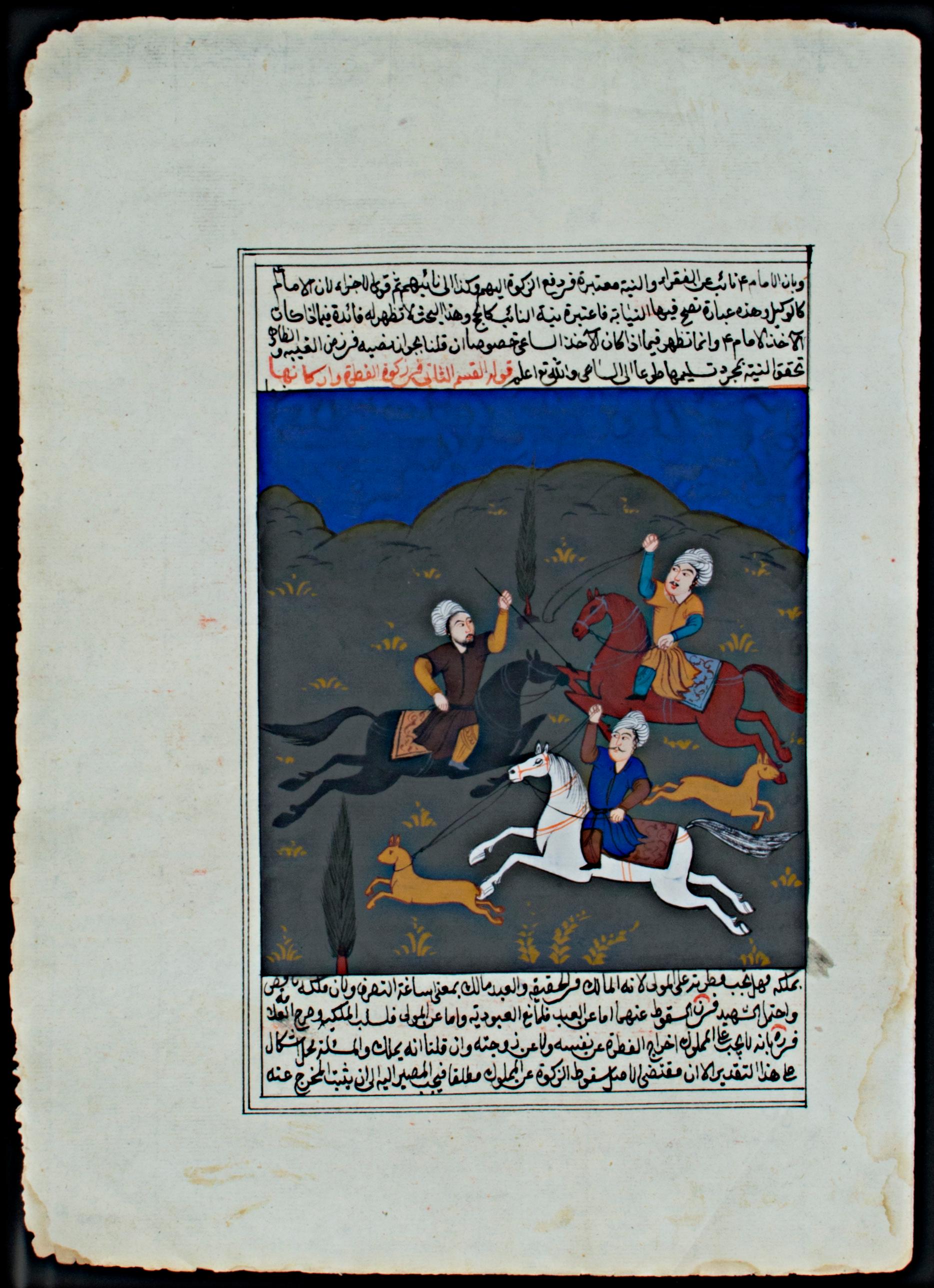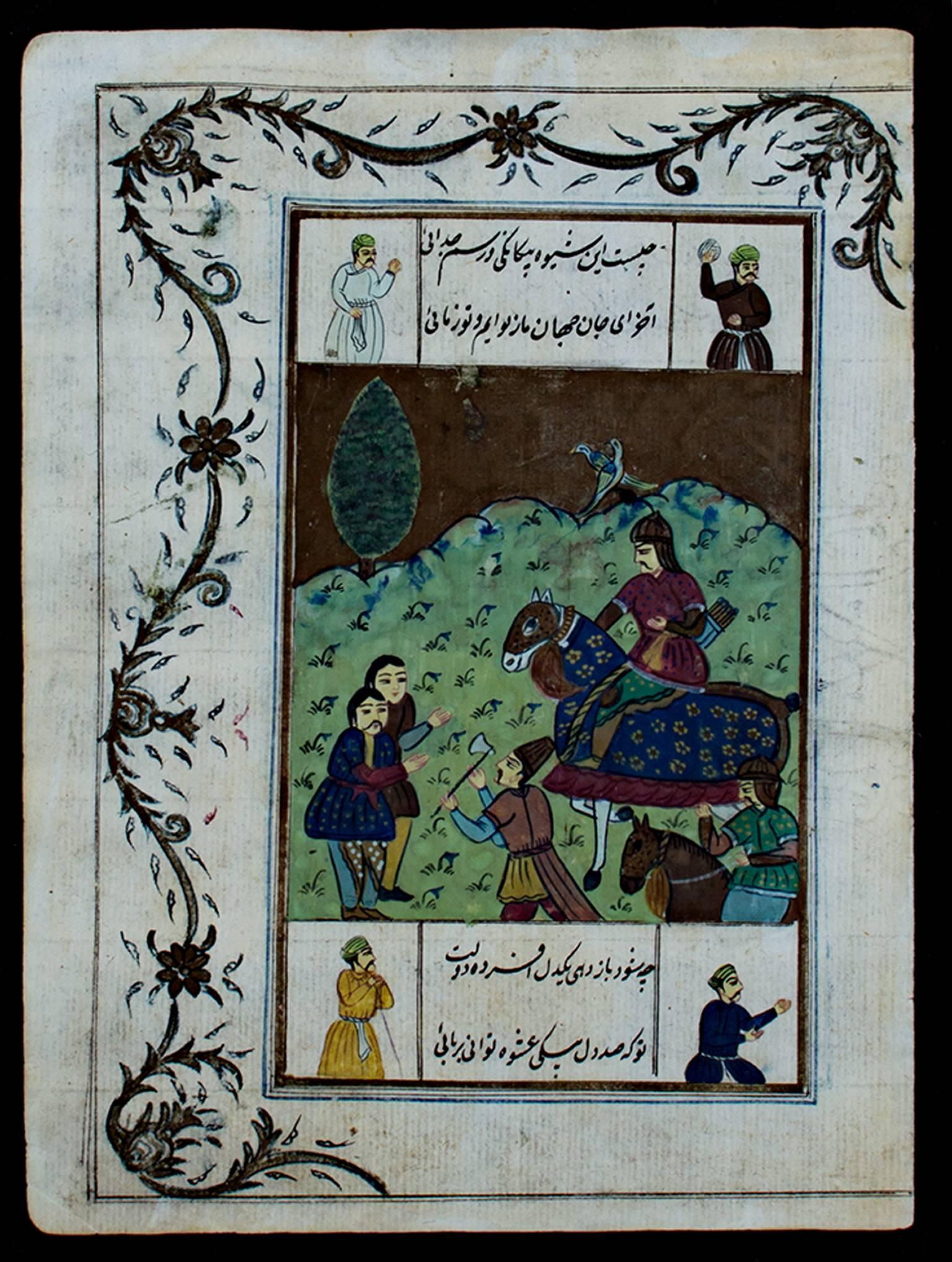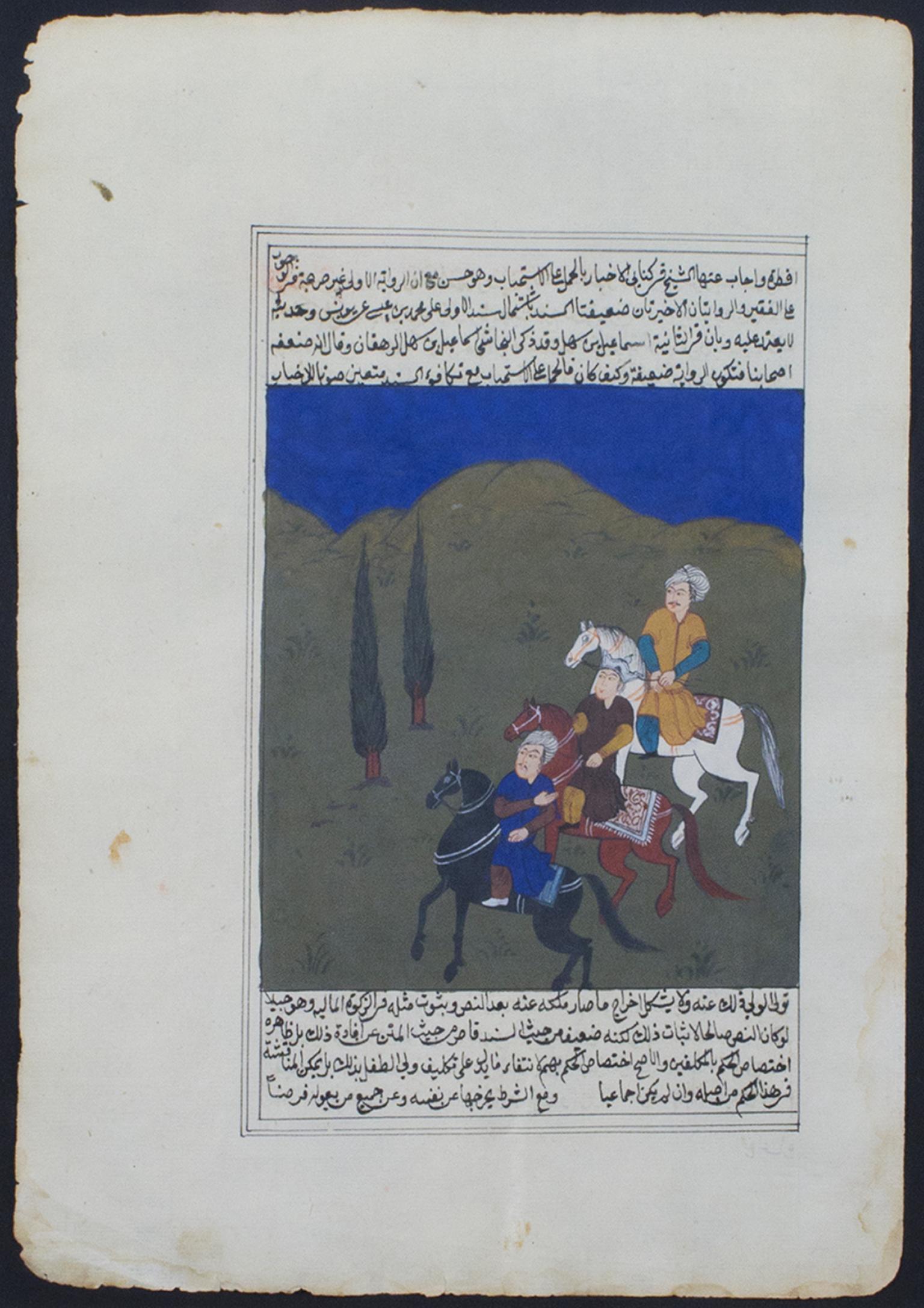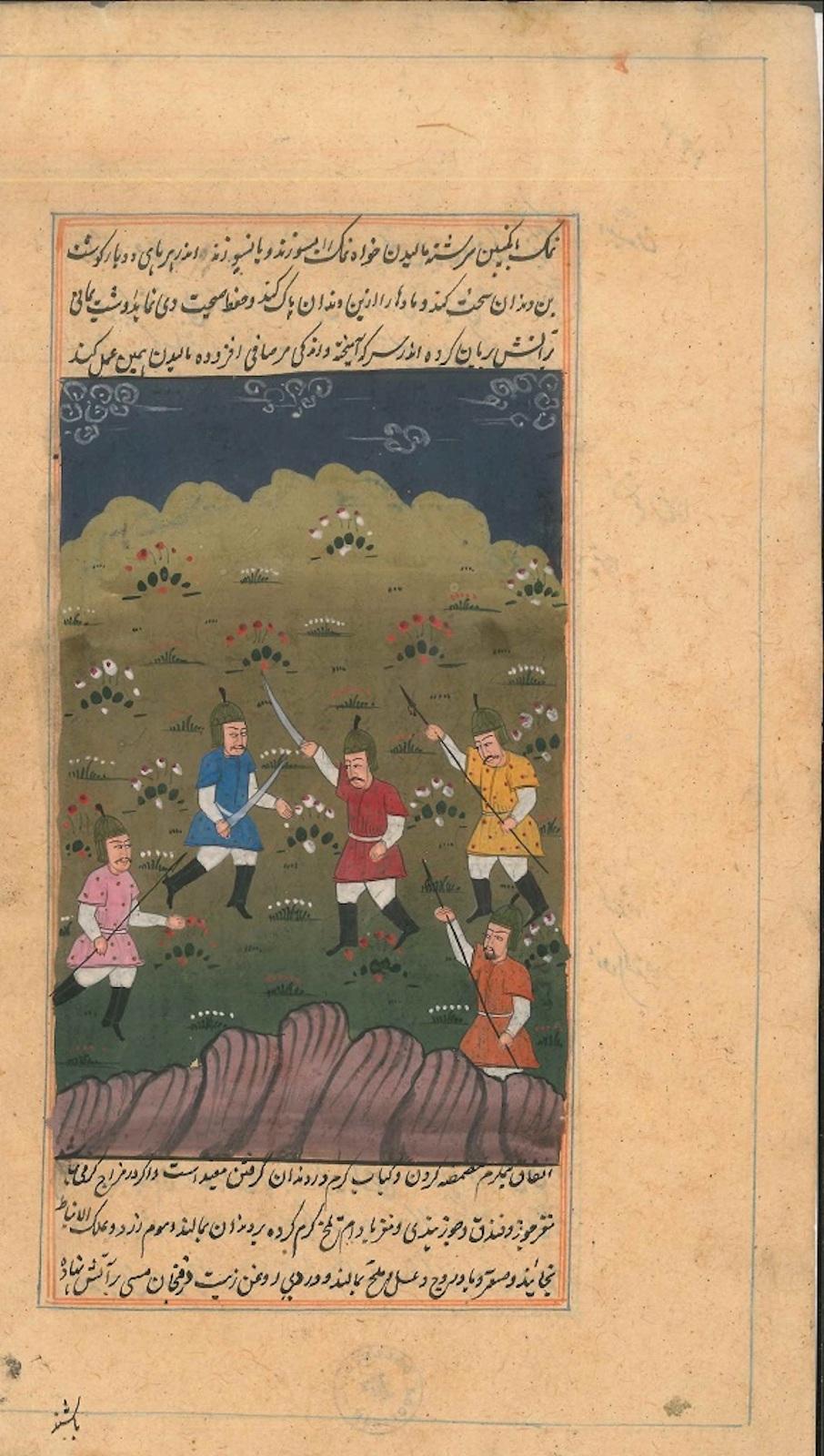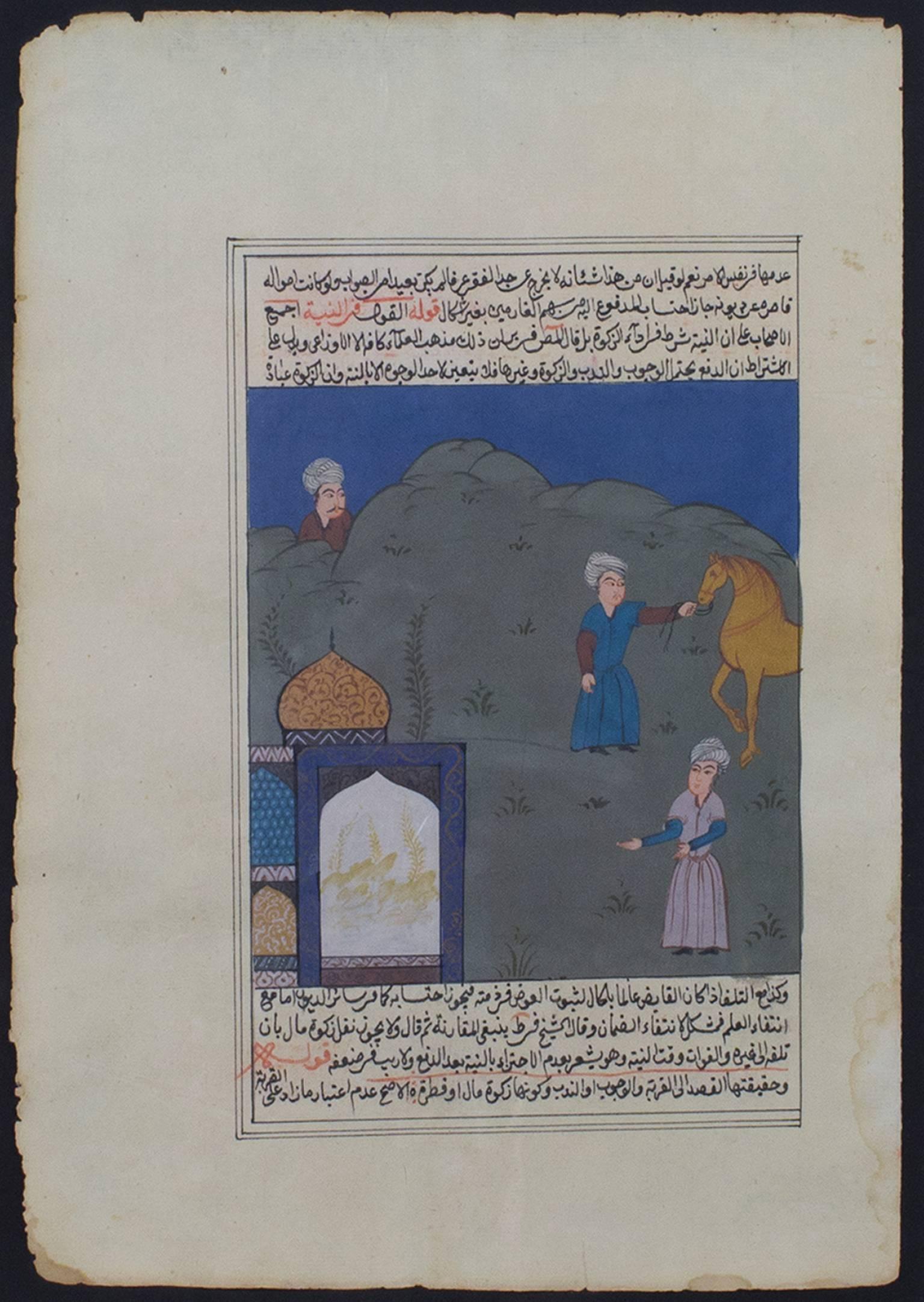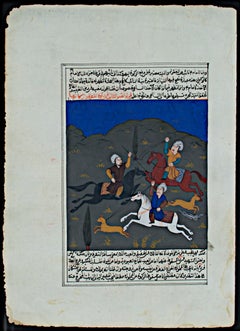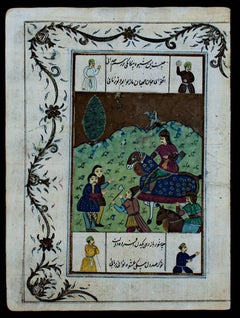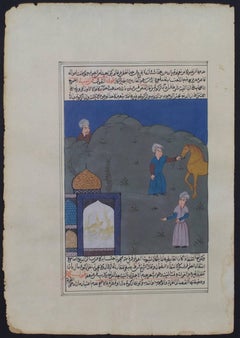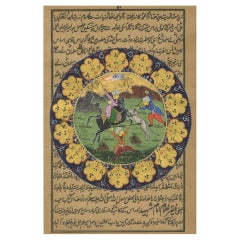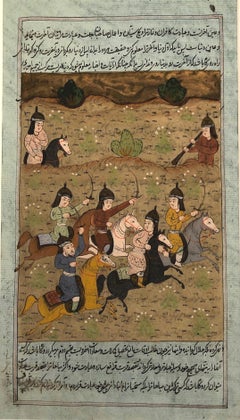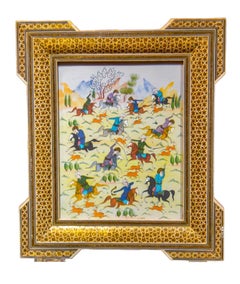Items Similar to Persian Illuminated Miniature with Four Figures Playing Polo in a Landscape
Want more images or videos?
Request additional images or videos from the seller
1 of 8
UnknownPersian Illuminated Miniature with Four Figures Playing Polo in a LandscapeLate 19th c.
Late 19th c.
$3,950
£3,044.97
€3,460.99
CA$5,628.17
A$6,122.87
CHF 3,230.94
MX$73,638.04
NOK 40,757.10
SEK 37,930.94
DKK 25,847.92
About the Item
The present illuminated folio page contains a fine miniature depicting four figures playing polo. Polo, also called 'chagun,' was the sport of kings and princes of central Asia and Iran, and the sport probably originated there in the 6th century BCE. Polo matches appear in a large number of early Persian texts, including in the writings of the 10th century epic writer Abu l-Qasim al-Firdawsi: He describes numerous polo matches in his famous 'Shahnameh' (The Persian Book of Kings). This particular illumination also is closely related to an example held at the Smithsonian Museum of Asian Art: a folio from 'Guy u Chawgan' (The ball and the polo-mallet) which shows a polo game with the dervish and the shah.
12 x 8.25 inches, artwork
19.75 x 15.88 inches, frame
accompanied on the back with an image of the verso
framed to conservation standards with a 100% rag silk-lined mat in a gold gilded frame
A Persian miniature is a small Persian painting on paper, whether a book illustration or a separate work of art intended to be kept in an album of such works called a muraqqa. The techniques are broadly comparable to the Western and Byzantine traditions of miniatures in illuminated manuscripts. Although there is an equally well-established Persian tradition of wall-painting, the survival rate and state of preservation of miniatures is better, and miniatures are much the best-known form of Persian painting in the West, and many of the most important examples are in Western, or Turkish, museums. Miniature painting became a significant genre in Persian art in the 13th century, receiving Chinese influence after the Mongol conquests, and the highest point in the tradition was reached in the 15th and 16th centuries. The tradition continued, under some Western influence, after this, and has many modern exponents. The Persian miniature was the dominant influence on other Islamic miniature traditions, principally the Ottoman miniature in Turkey, and the Mughal miniature in the Indian sub-continent.
Persian art under Islam had never completely forbidden the human figure, and in the miniature tradition the depiction of figures, often in large numbers, is central. This was partly because the miniature is a private form, kept in a book or album and only shown to those the owner chooses. It was therefore possible to be more free than in wall paintings or other works seen by a wider audience. The Qur'an and other purely religious works are not known to have been illustrated in this way, though histories and other works of literature may include religiously related scenes, including those depicting the Prophet Muhammed, after 1500 usually without showing his face.
As well as the figurative scenes in miniatures, which this article concentrates on, there was a parallel style of non-figurative ornamental decoration which was found in borders and panels in miniature pages, and spaces at the start or end of a work or section, and often in whole pages acting as frontispieces. In Islamic art this is referred to as "illumination", and manuscripts of the Qur'an and other religious books often included considerable number of illuminated pages. The designs reflected contemporary work in other media, in later periods being especially close to book-covers and Persian carpets, and it is thought that many carpet designs were created by court artists and sent to the workshops in the provinces.
In later periods miniatures were increasingly created as single works to be included in albums called muraqqa, rather than illustrated books. This allowed non-royal collectors to afford a representative sample of works from different styles and periods. [Wikipedia]
- Creation Year:Late 19th c.
- Dimensions:Height: 19.75 in (50.17 cm)Width: 15.88 in (40.34 cm)
- Medium:
- Period:
- Condition:Some water damage along the bottom. See images.
- Gallery Location:Milwaukee, WI
- Reference Number:Seller: 2001d1stDibs: LU60535979242
About the Seller
4.9
Gold Seller
Premium sellers maintaining a 4.3+ rating and 24-hour response times
Established in 1966
1stDibs seller since 2017
453 sales on 1stDibs
Typical response time: 1 hour
- ShippingRetrieving quote...Shipping from: Milwaukee, WI
- Return Policy
More From This Seller
View AllPersian Illuminated Miniature with Three Hunters on Horseback in a Landscape
Located in Milwaukee, WI
The present illuminated folio page contains a fine miniature depicting three figures hunting while on horseback, an image meant to accompany a historic epic. During the medieval period, hunting was an important pastime of male nobility throughout the Islamic world. The Quran itself explicitly endorses hunting and the use of animals to aid in capturing prey: "Lawful to you are foodstuffs that are good to eat and any game that, at your wish, is captured by beasts of prey which train as you do dogs, according to the method that Allah has taught you, after you have spoken the name of Allah over it." (Q 6:4) Muslim princes and nobles enjoyed the chase of the prey via horseback, using bow and arrow, crossbows, and blowpipes to capture their prey Horseback riding itself trained young men in the necessary skills for armed combat and warfare, developing their speed and strength.
12 x 8.25 inches, artwork
19.75 x 15.88 inches, frame
accompanied on the back with an image of the verso
framed to conservation standards with a 100% rag silk-lined mat in a gold gilded frame
A Persian miniature is a small Persian painting on paper, whether a book illustration or a separate work of art intended to be kept in an album of such works called a muraqqa. The techniques are broadly comparable to the Western and Byzantine traditions of miniatures in illuminated manuscripts. Although there is an equally well-established Persian tradition of wall-painting, the survival rate and state of preservation of miniatures is better, and miniatures are much the best-known form of Persian painting in the West, and many of the most important examples are in Western, or Turkish, museums. Miniature painting became a significant genre in Persian art in the 13th century, receiving Chinese influence after the Mongol conquests, and the highest point in the tradition was reached in the 15th and 16th centuries. The tradition continued, under some Western influence, after this, and has many modern exponents. The Persian miniature was the dominant influence on other Islamic miniature traditions, principally the Ottoman miniature...
Category
19th Century Other Art Style Figurative Paintings
Materials
Ink, Tempera, Laid Paper
"Two Warriors on Horseback, Foot Soldier, and Civilians, " Persian Book Page
Located in Milwaukee, WI
"Two Warriors on Horseback, Foot Soldier, and Civilians" is an original gold and tempera painting by an unknown Persian artist from the late 19th ...
Category
Late 19th Century Rajput Figurative Drawings and Watercolors
Materials
Gold Leaf
"Three Riders, Two Trees, " Tempera on Paper by Unknown Persian Artist
Located in Milwaukee, WI
"Three Riders, Two Trees" is an original tempera painting by an unknown Persian artist. it features three royal figures on three horses riding through ...
Category
Late 19th Century Rajput Figurative Drawings and Watercolors
Materials
Paper, Tempera
"Three Men with Horse & Building, " Tempera Page by Persian artist
Located in Milwaukee, WI
"Three Men with Horse & Building" is an original tempera painting by an unknown Persian artist from the late 19th century. It features a number of figu...
Category
Late 19th Century Rajput Figurative Drawings and Watercolors
Materials
Tempera
Persian Miniature (Three Figures Conversing)
Located in Milwaukee, WI
20th Century Persian oil painting on ivory
Category
20th Century Figurative Paintings
Materials
Oil
"Royalty Greeting Townspeople, " a Tempera Diptych from the Late 19th c.
Located in Milwaukee, WI
"Royalty Greeting Townspeople" is a Persian tempera diptych from the Late 19th century. It includes multiple figures in red and blue interacting in a f...
Category
Late 19th Century Other Art Style Figurative Prints
Materials
Tempera
You May Also Like
Vivid Safavid: Enchanted Tales of Persia - Gold Highlighted Miniature Manuscript
Located in Langweer, NL
A manuscript page containing Persian miniature painting, surrounded by script. This artwork is characteristic of Islamic manuscript illumination, pa...
Category
Antique Early 18th Century Persian Decorative Art
Materials
Paper
$490 Sale Price
30% Off
Ancient Persian Miniature: Men with Scimitar - Probably 18/19th Century
Located in Roma, IT
Image dimensions: 15 X 10 cm.
This Persian Miniature scene of men with scimitar is a unique precious original painting on the front with handwriting...
Category
18th Century Figurative Drawings and Watercolors
Materials
Ink, Tempera
19th Century Mughal Painting of Battle scene
Located in Greenwich, CT
An illuminated page from a book likely in reference to Emperor Jahangir's reign over the Mughal Empire.
Gouache and ink on light weight cream laid paper circa 1800 or earlier,
Exte...
Category
Late 19th Century Other Art Style Paintings
Materials
Gouache
Vintage Miniature Persian Painting of Hunters on Horseback
Located in Jacksonville, FL
A miniature antique Indo Persian Mughal Art mixed media painting on paper depicting a hunting scene in a landscape painted in bold colors and with fine details with a background of colorful mountains, blooming trees and Cypress trees. Antique Miniature Persian Paintings...
Category
20th Century Paintings
Materials
Mosaic
Persian Hunting Manuscript Handmade Painting Miniature Art
Located in Jacksonville, FL
Frame 13x10.75
(unframed) Size: 7.5 in. X 9.25 in. (19 cms X 28 cms)
Persian miniature painting in opaque watercolors with Persian writing, referring to a book and page 355. Depic...
Category
19th Century Paintings
Materials
Mosaic
Ancient Persian Miniature - Original China Ink and Watercolour - 19th Century
Located in Roma, IT
Ancient Persian Miniature is an original China Ink and Watercolour realized by an artist of 19th Century.
Good condition for a little brown ...
Category
19th Century Old Masters Figurative Drawings and Watercolors
Materials
Ink, Watercolor
More Ways To Browse
Antique Miniature Painting
Miniature Paintings From 19th Century
6th Century
Persian Miniature
Turkey Painting
Miniature Scene
19th Century Chinese Painting On Silk
Antique Book Covers
Antique Illuminated Manuscript
Antique Persian Painting
Antique Chinese Painting On Silk Panel
Antique Persian Miniatures
Illuminated Miniature
Turkish Miniature Painting
Persian Polo
Fabian Acrylic
Fantuzzi Eliano
Feroz Khan
